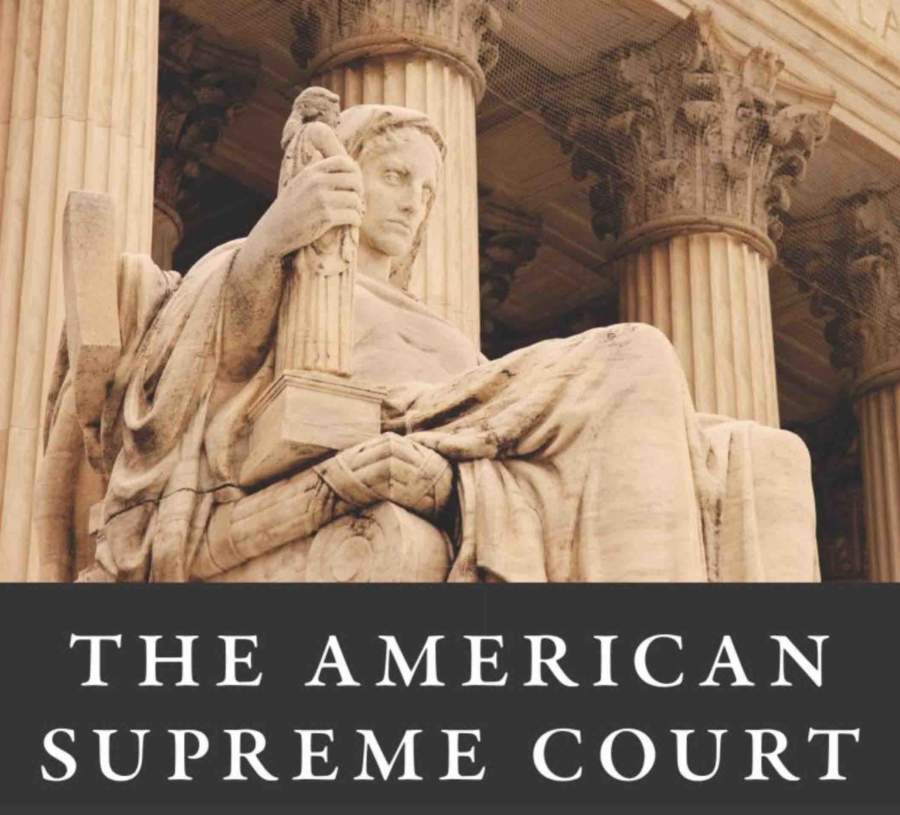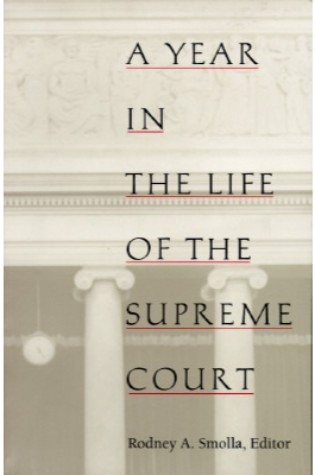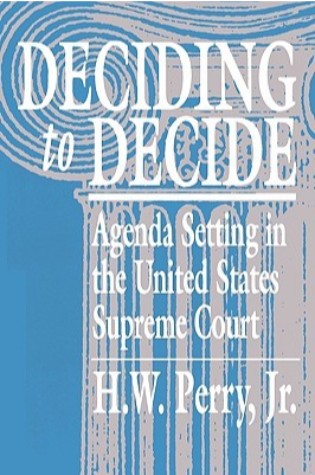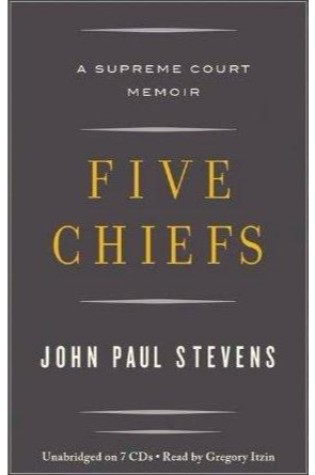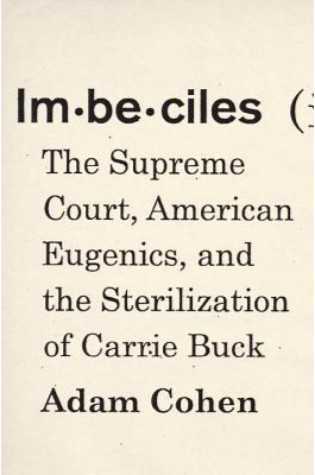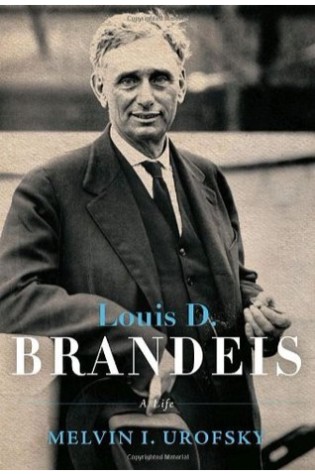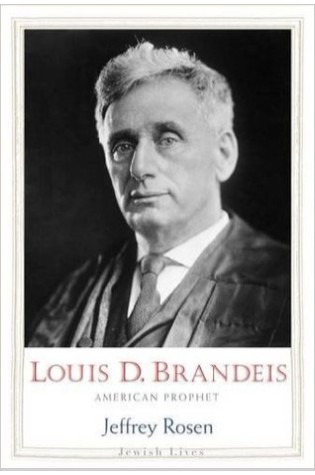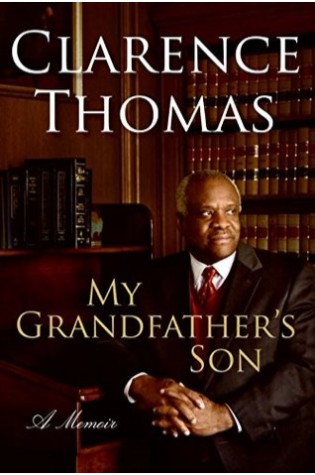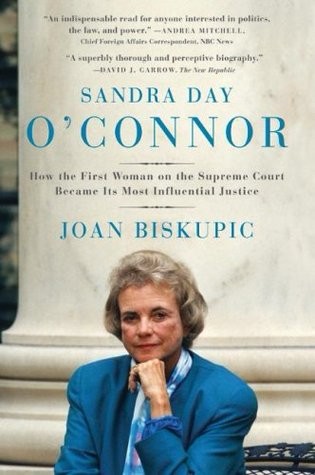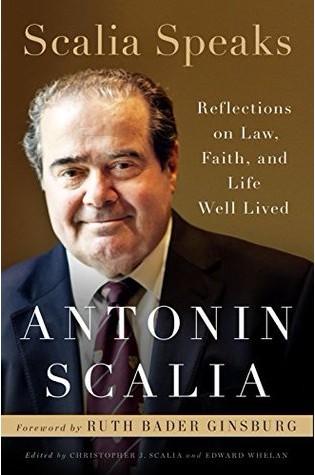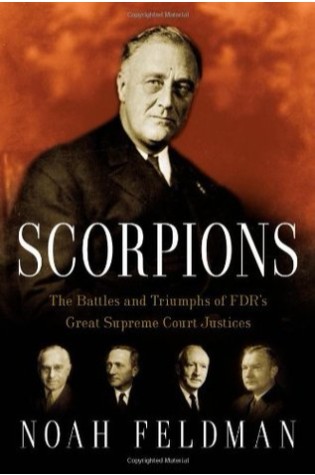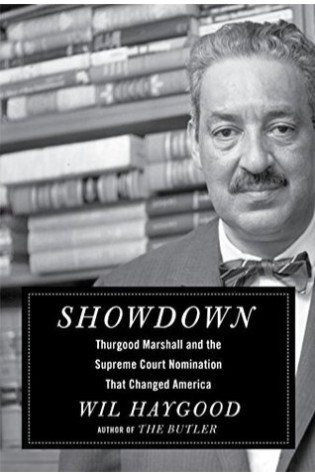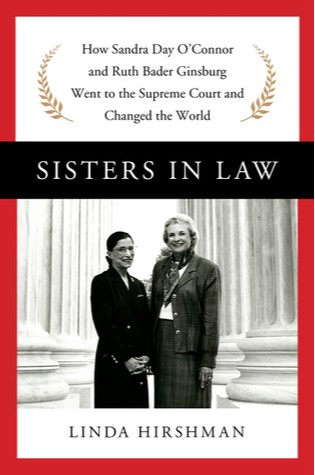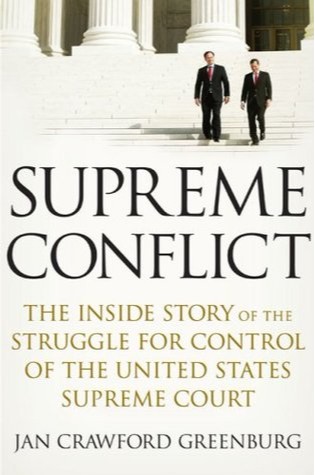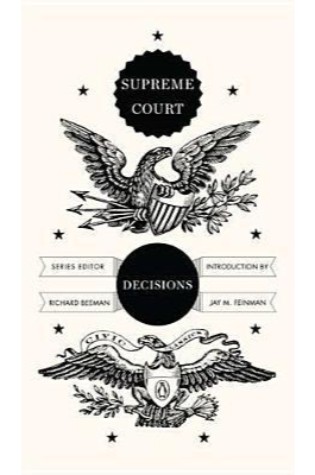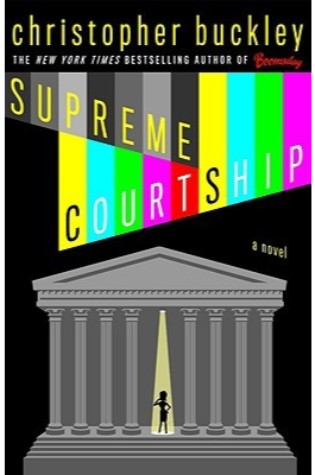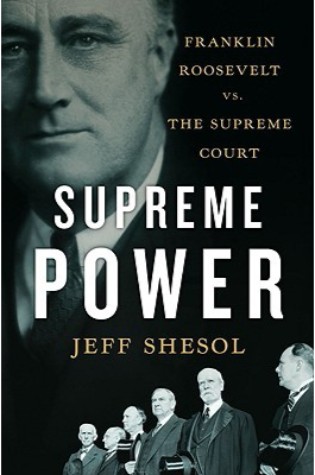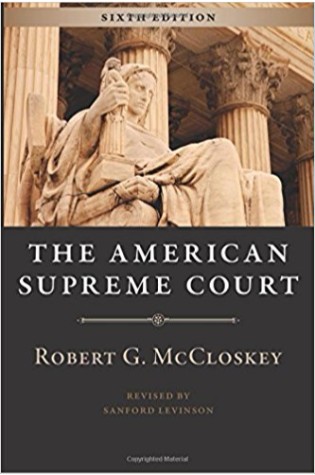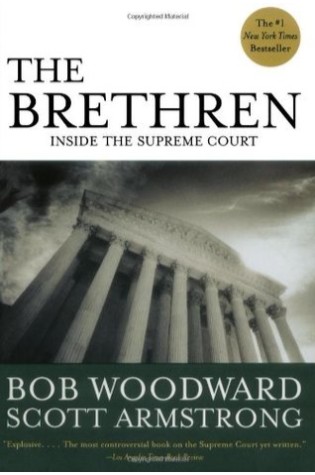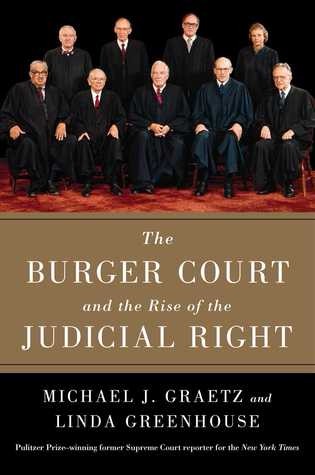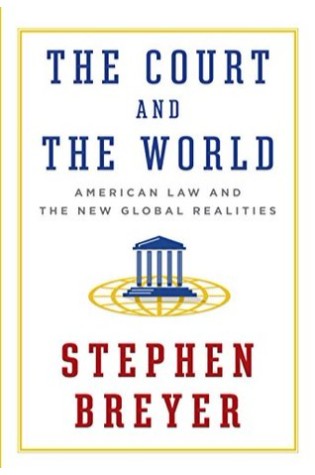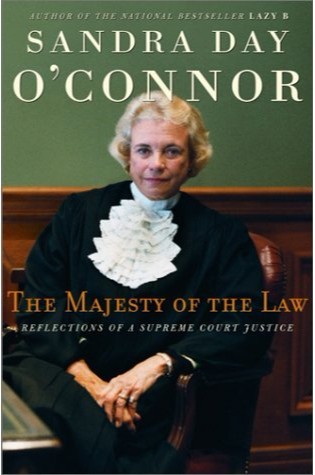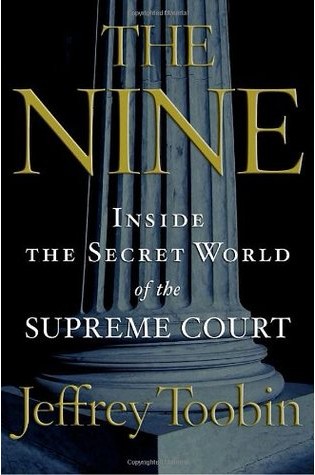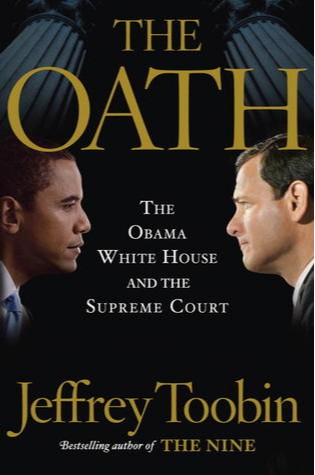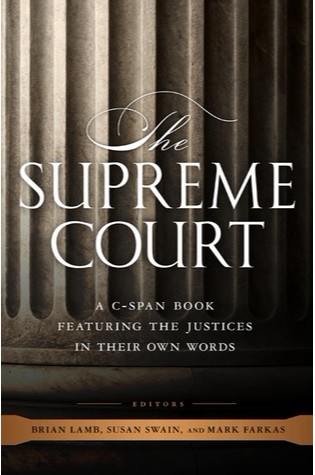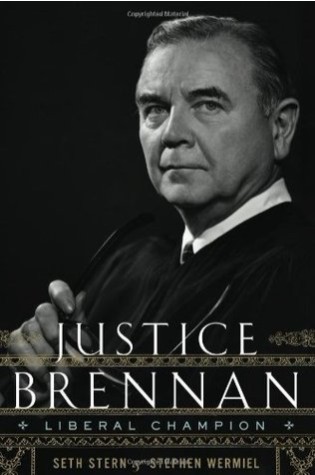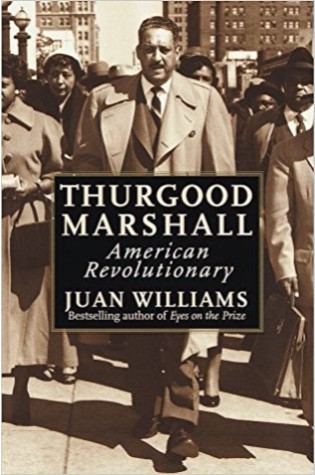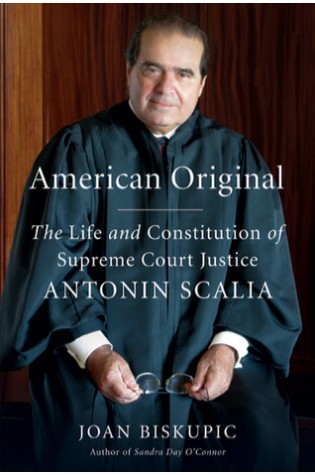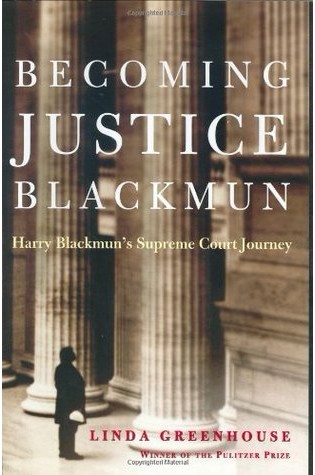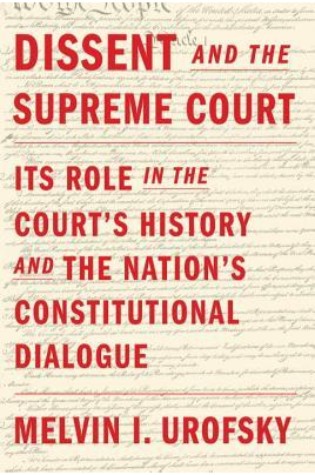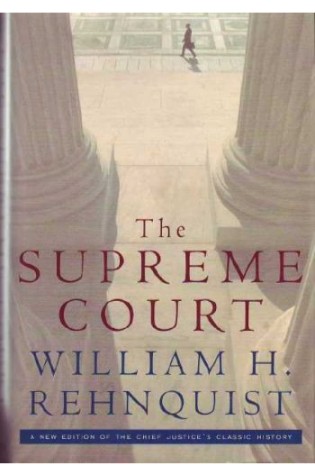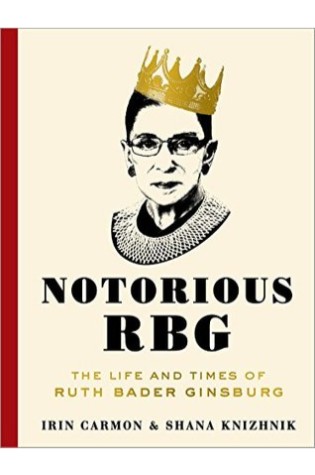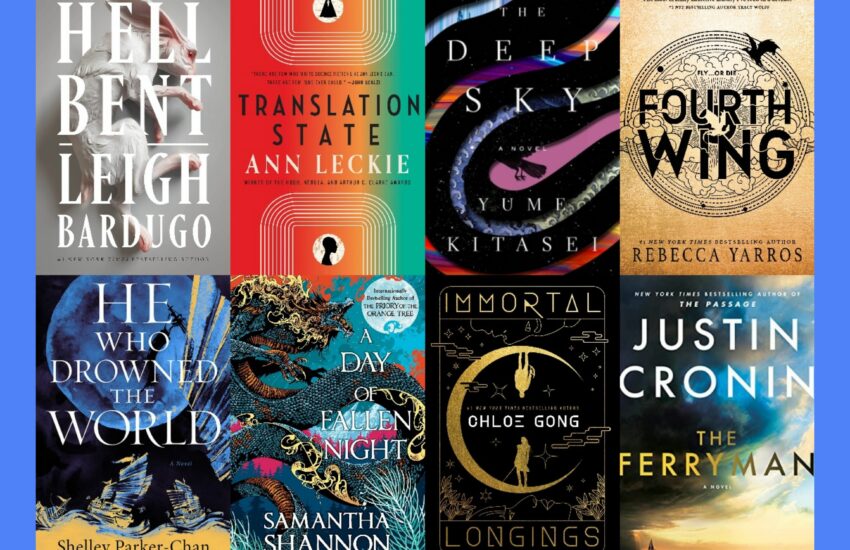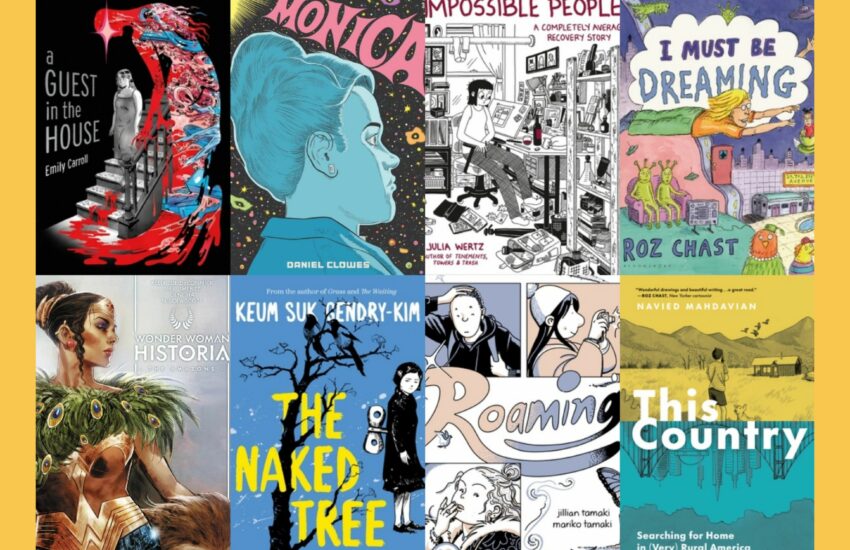The Best Books About The Supreme Court And The Supreme Court Justices
“What are the best books about The Supreme Court?” We looked at 153 of the top Supreme Court books, aggregating and ranking them so we could answer that very question!
The top 34 titles, all appearing on 2 or more “Best Supreme Court” book lists, are ranked below by how many lists they appear on. The remaining 100 titles, as well as the lists we used, are in alphabetical order at the bottom of the page.
Happy Scrolling!
Top 34 Supreme Court Books
34 .) A Year at the Supreme Court by Neal Devins and Davison M Douglas
Lists It Appears On:
- BiblioVault
- Streetlaw
The United States Supreme Court’s 2002–03 term confounded Court watchers. The same Rehnquist Court that many had seen as solidly conservative and unduly activist—the Court that helped decide the 2000 presidential election and struck down thirty-one federal statutes since 1995—issued a set of surprising, watershed rulings. In a term filled with important and unpredictable decisions, it upheld affirmative action, invalidated a same-sex sodomy statute, and reversed a death sentence due to ineffective assistance of counsel. With essays focused on individual Justices, Court practices, and some of last year’s most important rulings, this volume explores the meaning and significance of the Court’s 2002–03 term. Seasoned Supreme Court advocates and journalists from The New Republic, The Los Angeles Times, Newsweek, National Journal, Slate, and Legal Times grapple with questions about the Rehnquist Court’s identity and the Supreme Court’s role in the political life of the country.
33 .) A Year in the Life of the Supreme Court by Rodney A. Smolla
Lists It Appears On:
- BiblioVault
- Streetlaw
“Despite its importance to the life of the nation and all its citizens, the Supreme Court remains a mystery to most Americans, its workings widely felt but rarely seen firsthand. In this book, journalists who cover the Court—acting as the eyes and ears of not just the American people, but the Constitution itself—give us a rare close look into its proceedings, the people behind them, and the complex, often fascinating ways in which justice is ultimately served. Their narratives form an intimate account of a year in the life of the Supreme Court.
The cases heard by the Surpreme Court are, first and foremost, disputes involving real people with actual stories. The accidents and twists of circumstance that have brought these people to the last resort of litigation can make for compelling drama. The contributors to this volume bring these dramatic stories to life, using them as a backdrop for the larger issues of law and social policy that constitute the Court’s business: abortion, separation of church and state, freedom of speech, the right of privacy, crime, violence, discrimination, and the death penalty. In the course of these narratives, the authors describe the personalities and jurisprudential leanings of the various Justices, explaining how the interplay of these characters and theories about the Constitution interact to influence the Court’s decisions.”
32 .) Deciding to Decide: Agenda Setting in the United States Supreme Court by H.W. Perry
Lists It Appears On:
- BiblioVault
- Streetlaw
Of the nearly five thousand cases presented to the Supreme Court each year, less than 5 percent are granted review. How the Court sets its agenda, therefore, is perhaps as important as how it decides cases. H. W. Perry, Jr., takes the first hard look at the internal workings of the Supreme Court, illuminating its agenda-setting policies, procedures, and priorities as never before. He conveys a wealth of new information in clear prose and integrates insights he gathered in unprecedented interviews with five justices. For this unique study Perry also interviewed four U.S. solicitors general, several deputy solicitors general, seven judges on the D.C. Circuit Court of Appeals, and sixty-four former Supreme Court law clerks.The clerks and justices spoke frankly with Perry, and his skillful analysis of their responses is the mainspring of this book. His engaging report demystifies the Court, bringing it vividly to life for general readers–as well as political scientists and a wide spectrum of readers throughout the legal profession.Perry not only provides previously unpublished information on how the Court operates but also gives us a new way of thinking about the institution. Among his contributions is a decision-making model that is more convincing and persuasive than the standard model for explaining judicial behavior.
31 .) Five Chiefs: A Supreme Court Memoir by John Paul Stevens
Lists It Appears On:
- Goodreads
- The Boston Globe
In Five Chiefs, Justice Stevens captures the inner workings of the Supreme Court via his personal experiences with the five Chief Justices–Fred Vinson, Earl Warren, Warren Burger, William Rehnquist, and John Roberts–that he interacted with. He reminisces of being a law clerk during Vinson’s tenure; a practicing lawyer for Warren; a circuit judge and junior justice for Burger; a contemporary colleague of Rehnquist; and a colleague of current Chief Justice John Roberts. Along the way, he will discuss his views of some the most significant cases that have been decided by the Court from Vinson, who became Chief Justice in 1946 when Truman was President, to Roberts, who became Chief Justice in 2005.
30 .) Imbeciles: The Supreme Court, American Eugenics, and the Sterilization of Carrie Buck by Adam Cohen
Lists It Appears On:
- Goodreads
- Scotus Blog
“In 1927, the Supreme Court handed down a ruling so disturbing, ignorant, and cruel that it stands as one of the great injustices in American history. In Imbeciles, bestselling author Adam Cohen exposes the court’s decision to allow the sterilization of a young woman it wrongly thought to be “feebleminded” and to champion the mass eugenic sterilization of undesirable citizens for the greater good of the country. The 8–1 ruling was signed by some of the most revered figures in American law—including Chief Justice William Howard Taft, a former U.S. president; and Louis Brandeis, a progressive icon. Oliver Wendell Holmes, considered by many the greatest Supreme Court justice in history, wrote the majority opinion, including the court’s famous declaration “Three generations of imbeciles are enough.”
Imbeciles is the shocking story of Buck v. Bell, a legal case that challenges our faith in American justice. A gripping courtroom drama, it pits a helpless young woman against powerful scientists, lawyers, and judges who believed that eugenic measures were necessary to save the nation from being “swamped with incompetence.” At the center was Carrie Buck, who was born into a poor family in Charlottesville, Virginia, and taken in by a foster family, until she became pregnant out of wedlock. She was then declared “feebleminded” and shipped off to the Colony for Epileptics and Feeble-Minded.”
29 .) The Tenth Justice by Brad Meltzer
Lists It Appears On:
- Aba Journal
- Goodreads
Ben Addison, fresh from Yale Law, is a new clerk for one of the Supreme Court’s most respected justices. But when he accidentally reveals the secret outcome of an upcoming decision, a blackmailer makes millions and Ben starts to sweat. Big time. He turns to his co-clerk, Lisa, and his housemates, Nathan, Eric, and Ober, for help. Washington’s best and brightest, they offer coveted insider access to the State Department, a major Washington newspaper, and the Senate. But before they know it, their careers-and their lives-are on the line. Where does loyalty end? Where does greed begin? And how much can you really trust your friends?
28 .) Louis D. Brandeis: A Life by Melvin I. Urofsky
Lists It Appears On:
- Goodreads
- The New York Times
“Louis Dembitz Brandeis had at least four “careers.” As a lawyer in the late nineteenth and early twentieth centuries, he pioneered how modern law is practiced. He, and others, developed the modern law firm, in which specialists manage different areas of the law. He was the author of the right to privacy; led the way in creating the role of the lawyer as counselor; and pioneered the idea of pro bono publico work by attorneys. As late as 1916, when Brandeis was nominated to the Supreme Court, the idea of pro bono service still struck many old-time attorneys as somewhat radical.
Between 1895 and 1916, when Woodrow Wilson named Brandeis to the Supreme Court, he ranked as one of the nation’s leading progressive reformers. Brandeis invented savings bank life insurance in Massachusetts (he considered it his most important contribution to the public weal) and was a driving force in the development of the Federal Reserve Act, the Clayton Antitrust Act, and the law establishing the Federal Trade Commission.”
27 .) Louis D. Brandeis: American Prophet by Jeffrey Rosen
Lists It Appears On:
- Goodreads
- Signature Reads
According to Jeffrey Rosen, Louis D. Brandeis was “the Jewish Jefferson,” the greatest critic of what he called “the curse of bigness,” in business and government, since the author of the Declaration of Independence. Published to commemorate the hundredth anniversary of his Supreme Court confirmation on June 1, 1916, Louis D. Brandeis: American Prophet argues that Brandeis was the most farseeing constitutional philosopher of the twentieth century. In addition to writing the most famous article on the right to privacy, he also wrote the most important Supreme Court opinions about free speech, freedom from government surveillance, and freedom of thought and opinion. And as the leader of the American Zionist movement, he convinced Woodrow Wilson and the British government to recognize a Jewish homeland in Palestine. Combining narrative biography with a passionate argument for why Brandeis matters today, Rosen explores what Brandeis, the Jeffersonian prophet, can teach us about historic and contemporary questions involving the Constitution, monopoly, corporate and federal power, technology, privacy, free speech, and Zionism.
26 .) Making Our Democracy Work: A Judge’s View by Stephen G. Breyer
Lists It Appears On:
- Goodreads
- Streetlaw
“The Supreme Court is one of the most extraordinary institutions in our system of government. Charged with the responsibility of interpreting the Constitution, the nine unelected justices of the Court have the awesome power to strike down laws enacted by our elected representatives. Why does the public accept the Court’s decisions as legitimate and follow them, even when those decisions are highly unpopular? What must the Court do to maintain the public’s faith? How can the Court help make our democracy work? These are the questions that Justice Stephen Breyer tackles in this groundbreaking book.
Today we assume that when the Court rules, the public will obey. But Breyer declares that we cannot take the public’s confidence in the Court for granted. He reminds us that at various moments in our history, the Court’s decisions were disobeyed or ignored. And through investigations of past cases, concerning the Cherokee Indians, slavery, and Brown v. Board of Education, he brilliantly captures the steps—and the missteps—the Court took on the road to establishing its legitimacy as the guardian of the Constitution.”
25 .) My Grandfather’s Son by Clarence Thomas
Lists It Appears On:
- Goodreads
- Five Books
Provocative, inspiring, and unflinchingly honest, My Grandfather’s Son is the story of one of America’s most remarkable and controversial leaders, Supreme Court justice Clarence Thomas, told in his own words.
24 .) Sandra Day O’Connor: How the First Woman on the Supreme Court Became Its Most Influential Justice by Joan Biskupic
Lists It Appears On:
- Goodreads
- Streetlaw
Sandra Day O’Connor, America’s first woman justice, was called the most powerful woman in America. She became the axis on which the Supreme Court turned, and it was often said that to gauge the direction of American law, one need look only to O’Connor’s vote. Drawing on information gleaned from once-private papers, hundreds of interviews, and the insight gained from nearly two decades of covering the Supreme Court, author Joan Biskupic offers readers a fascinating portrait of a complex and multifaceted woman—lawyer, politician, legislator, and justice, as well as wife, mother, A-list society hostess, and competitive athlete. Biskupic provides an in-depth account of her transformation from tentative jurist to confident architect of American law.
23 .) Scalia Speaks: Reflections on Law, Faith, and Life Well Lived by Antonin Scalia, edited by Christopher J. Scalia and Edward Whelan
Lists It Appears On:
- Goodreads
- Signature Reads
This definitive collection of beloved Supreme Court Justice Antonin Scalia’s finest speeches covers topics as varied as the law, faith, virtue, pastimes, and his heroes and friends. Featuring a foreword by longtime friend Justice Ruth Bader Ginsburg and an intimate introduction by his youngest son, this volume includes dozens of speeches, some deeply personal, that have never before been published. Christopher J. Scalia and the Justice’s former law clerk Edward Whelan selected the speeches.
22 .) Scorpions: The Battles and Triumphs of FDR’s Great Supreme Court Justices by Noah Feldman
Lists It Appears On:
- Goodreads
- Streetlaw
“A tiny, ebullient Jew who started as America’s leading liberal and ended as its most famous judicial conservative. A Klansman who became an absolutist advocate of free speech and civil rights. A backcountry lawyer who started off trying cases about cows and went on to conduct the most important international trial ever. A self-invented, tall-tale Westerner who narrowly missed the presidency but expanded individual freedom beyond what anyone before had dreamed.
Four more different men could hardly be imagined. Yet they had certain things in common. Each was a self-made man who came from humble beginnings on the edge of poverty. Each had driving ambition and a will to succeed. Each was, in his own way, a genius. “
21 .) Showdown: Thurgood Marshall and the Supreme Court Nomination That Changed America by Wil Haygood
Lists It Appears On:
- Scotus Blog
- The New York Times
“Thurgood Marshall brought down the separate-but-equal doctrine, integrated schools, and not only fought for human rights and human dignity but also made them impossible to deny in the courts and in the streets. In this stunning new biography, award-winning author Wil Haygood surpasses the emotional impact of his inspiring best seller The Butler to detail the life and career of one of the most transformative legal minds of the past one hundred years.
Using the framework of the dramatic, contentious five-day Senate hearing to confirm Marshall as the first African-American Supreme Court justice, Haygood creates a provocative and moving look at Marshall’s life as well as the politicians, lawyers, activists, and others who shaped—or desperately tried to stop—the civil rights movement of the twentieth century: President Lyndon Johnson; Congressman Adam Clayton Powell Jr., whose scandals almost cost Marshall the Supreme Court judgeship; Harry and Harriette Moore, the Florida NAACP workers killed by the KKK; Justice J. Waties Waring, a racist lawyer from South Carolina, who, after being appointed to the federal court, became such a champion of civil rights that he was forced to flee the South; John, Robert, and Ted Kennedy; Senator Strom Thurmond, the renowned racist from South Carolina, who had a secret black mistress and child; North Carolina senator Sam Ervin, who tried to use his Constitutional expertise to block Marshall’s appointment; Senator James Eastland of Mississippi, the head of the Senate Judiciary Committee, who stated that segregation was “the law of nature, the law of God”; Arkansas senator John McClellan, who, as a boy, after Teddy Roosevelt invited Booker T. Washington to dinner at the White House, wrote a prize-winning school essay proclaiming that Roosevelt had destroyed the integrity of the presidency; and so many others.”
20 .) Sisters in Law: How Sandra Day O’Connor and Ruth Bader Ginsburg Went to the Supreme Court and Changed the World by Linda Hirshman
Lists It Appears On:
- Goodreads
- Scotus Blog
“The relationship between Sandra Day O’Connor and Ruth Bader Ginsburg—Republican and Democrat, Christian and Jew, western rancher’s daughter and Brooklyn girl—transcends party, religion, region, and culture. Strengthened by each other’s presence, these groundbreaking judges, the first and second to serve on the highest court in the land, have transformed the Constitution and America itself, making it a more equal place for all women.
Linda Hirshman’s dual biography includes revealing stories of how these trailblazers fought for their own recognition in a male-dominated profession—battles that would ultimately benefit every American woman. She also makes clear how these two justices have shaped the legal framework of modern feminism, including employment discrimination, abortion, affirmative action, sexual harassment, and many other issues crucial to women’s lives.”
19 .) Supreme Conflict: The Inside Story of the Struggle for Control of the United States Supreme Court by Jan Crawford Greenburg
Lists It Appears On:
- Goodreads
- Streetlaw
A straightforward account of the struggle for control over the nation’s highest court describes how Rehnquist’s court proved disappointing to conservatives despite its seven Republican nominees, the story behind a series of failed Republican nominations, and George W. Bush’s direct role in launching a conservative counter-revolution.
18 .) Supreme Court Decisions by Jay M. Feinman; Series Editor Richard Beeman
Lists It Appears On:
- BiblioVault
- Signature Reads
The Supreme Court is one of America’s leading expositors of and participants in debates about American values. Legal expert Jay M. Feinman introduces and selects some of the most important Supreme Court Decisions of all time, which touch on the very foundations of American society. These cases cover a vast array of issues, from the powers of government and freedom of speech to freedom of religion and civil liberties. Feinman offers commentary on each case and excerpts from the opinions of the Justices that show the range of debate in the Supreme Court and its importance to civil society. Among the cases included will be Marbury v. Madison, on the supremacy of the Constitution and the power of judicial review; U.S. v. Nixon, on separation of powers; and Hamdi v. Rumsfeld, a post-9/11 case on presidential power and due process.
17 .) Supreme Courtship by Christopher Buckley
Lists It Appears On:
- Aba Journal
- Goodreads
“President of the United States Donald Vanderdamp is having a hell of a time getting his nominees appointed to the Supreme Court. After one nominee is rejected for insufficiently appreciating To Kill A Mockingbird, the president chooses someone so beloved by voters that the Senate won’t have the guts to reject her — Judge Pepper Cartwright, the star of the nation’s most popular reality show, Courtroom Six.
Will Pepper, a straight-talking Texan, survive a confirmation battle in the Senate? Will becoming one of the most powerful women in the world ruin her love life? And even if she can make it to the Supreme Court, how will she get along with her eight highly skeptical colleagues, including a floundering Chief Justice who, after legalizing gay marriage, learns that his wife has left him for another woman. “
16 .) Supreme Power: Franklin Roosevelt vs. the Supreme Court by Jeff Shesol
Lists It Appears On:
- Five Books
- Goodreads
“Beginning in 1935, in a series of devastating decisions, the Supreme Court’s conservative majority left much of FDR’s agenda in ruins. The pillars of the New Deal fell in short succession. It was not just the New Deal, but democracy itself, that stood on trial. In February 1937, Roosevelt struck back with an audacious plan to expand the Court to fifteen justices―and to “pack” the new seats with liberals who shared his belief in a “living” Constitution.
The ensuing fight was a firestorm that engulfed the White House, the Court, Congress, and the nation. The final verdict was a shock. It dealt FDR the biggest setback of his political life, split the Democratic party, and set the stage for a future era of Republican dominance. Yet the battle also transformed America’s political and constitutional landscape, hastening the nation’s march into the modern world.
“
15 .) The American Supreme Court
Lists It Appears On:
- American Bar
- BiblioVault
As in prior editions, McCloskey’s original text remains unchanged. In his historical interpretation, he argues that the strength of the Court has always been its sensitivity to the changing political scene, as well as its reluctance to stray too far from the main currents of public sentiment. In this new edition, Sanford Levinson extends McCloskey’s magisterial treatment to address developments since the 2010 election, including the Supreme Court’s decisions regarding the Defense of Marriage Act, the Affordable Care Act, and gay marriage.
14 .) The Brethren: Inside the Supreme Court by Bob Woodward
Lists It Appears On:
- Goodreads
- The Boston Globe
The Brethren is the first detailed behind-the-scenes account of the Supreme Court in action. Bob Woodward and Scott Armstrong have pierced its secrecy to give us an unprecedented view of the Chief and Associate Justices — maneuvering, arguing, politicking, compromising and making decisions that affect every major area of American life.
13 .) The Burger Court and the Rise of the Judicial Right by Michael J. Graetz and Linda Greenhouse
Lists It Appears On:
- Goodreads
- Signature Reads
When Richard Nixon campaigned for the presidency in 1968 he promised to change the Supreme Court. With four appointments to the court, including Warren E. Burger as the chief justice, he did just that. In 1969, the Burger Court succeeded the famously liberal Warren Court, which had significantly expanded civil liberties and was despised by conservatives across the country.
12 .) The Court and the World: American Law and the New Global Realities by Stephen G. Breyer
Lists It Appears On:
- Goodreads
- Scotus Blog
“It is a world of instant communications, lightning-fast commerce, and shared problems (like public health threats and environmental degradation), and it is one in which the lives of Americans are routinely linked ever more pervasively to those of people in foreign lands. Indeed, at a moment when anyone may engage in direct transactions internationally for services previously bought and sold only locally (lodging, for instance, through online sites), it has become clear that, even in ordinary matters, judicial awareness can no longer stop at the water’s edge.
To trace how foreign considerations have come to inform the thinking of the Court, Justice Breyer begins with that area of the law in which they have always figured prominently: national security in its constitutional dimension—how should the Court balance this imperative with others, chiefly the protection of basic liberties, in its review of presidential and congressional actions? He goes on to show that as the world has grown steadily “smaller,” the Court’s horizons have inevitably expanded: it has been obliged to consider a great many more matters that now cross borders. What is the geographical reach of an American statute concerning, say, securities fraud, antitrust violations, or copyright protections? And in deciding such matters, can the Court interpret American laws so that they might work more efficiently with similar laws in other nations?”
11 .) The Majesty of the Law: Reflections of a Supreme Court Justice by Sandra Day O’Connor
Lists It Appears On:
- Goodreads
- Streetlaw
In this remarkable book, a national bestseller in hardcover, Sandra Day O’Connor explores the law, her life as a Supreme Court Justice, and how the Court has evolved and continues to function, grow, and change as an American institution. Tracing some of the origins of American law through history, people, ideas, and landmark cases, O’Connor sheds new light on the basics, exploring through personal observation the evolution of the Court and American democratic traditions. Straight-talking, clear-eyed, inspiring, The Majesty of the Law is more than a reflection on O’Connor’s own experiences as the first female Justice of the Supreme Court; it also reveals some of the things she has learned and believes about American law and life—reflections gleaned over her years as one of the most powerful and inspiring women in American history.
10 .) The Nine: Inside the Secret World of the Supreme Court by Jeffrey Toobin
Lists It Appears On:
- Goodreads
- The Boston Globe
Based on exclusive interviews with justices themselves, The Nine tells the story of the Court through personalities—from Anthony Kennedy’s overwhelming sense of self-importance to Clarence Thomas’s well-tended grievances against his critics to David Souter’s odd nineteenth-century lifestyle. There is also, for the first time, the full behind-the-scenes story of Bush v. Gore—and Sandra Day O’Connor’s fateful breach with George W. Bush, the president she helped place in office.
9 .) The Oath: The Obama White House and The Supreme Court by Jeffrey Toobin
Lists It Appears On:
- Goodreads
- The Boston Globe
“From the moment John Roberts, the chief justice of the United States, blundered through the Oath of Office at Barack Obama’s inauguration, the relationship between the Supreme Court and the White House has been confrontational. Both men are young, brilliant, charismatic, charming, determined to change the course of the nation—and completely at odds on almost every major constitutional issue. One is radical; one essentially conservative. The surprise is that Obama is the conservative—a believer in incremental change, compromise, and pragmatism over ideology. Roberts—and his allies on the Court—seek to overturn decades of precedent: in short, to undo the ultimate victory FDR achieved in the New Deal.
This ideological war will crescendo during the 2011-2012 term, in which several landmark cases are on the Court’s docket—most crucially, a challenge to Obama’s controversial health-care legislation. With four new justices joining the Court in just five years, including Obama’s appointees Sonia Sotomayor and Elena Kagan, this is a dramatically—and historically—different Supreme Court, playing for the highest of stakes.”
8 .) The Supreme Court: A C-Span Book Featuring the Justices in Their Own Words by C-SPAN
Lists It Appears On:
- Streetlaw
- The Boston Globe
This singular collection of original interviews with all nine sitting Supreme Court justices plus retired Justice Sandra Day O’Connor–as well as reporters, attorneys, and historians–gives readers a rare window into the nation’s highest court and those who serve there.
7 .) Justice Brennan: Liberal Champion by Seth Stern and Stephen
Lists It Appears On:
- Five Books
- Goodreads
Before his death, William Brennan granted Stephen Wermiel access to volumes of personal and court materials that are sealed to the public until 2017. These are what Jeffrey Toobin has called “a coveted set of documents” that includes Brennan’s case histories—in which he recorded strategies behind all the major battles of the past half century, including Roe v. Wade, affirmative action, the death penalty, obscenity law, and the constitutional right to privacy—as well as more personal documents that reveal some of Brennan’s curious contradictions, like his refusal to hire female clerks even as he wrote groundbreaking women’s rights decisions; his complex stance as a justice and a Catholic; and details on Brennan’s unprecedented working relationship with Chief Justice Earl Warren. Wermiel distills decades of valuable information into a seamless, riveting portrait of the man behind the Court’s most liberal era.
6 .) Thurgood Marshall: American Revolutionary by Juan Williams
Lists It Appears On:
- Goodreads
- Signature Reads
“Thurgood Marshall stands today as the great architect of American race relations, having expanded the foundation of individual rights for all Americans. His victory in the Brown v. Board of Education decision in 1954, the landmark Supreme Court case outlawing school segregation, would have made him a historic figure even if he had not gone on to become the first African-American appointed to the Supreme Court. As a young lawyer, Marshall dealt with criminal cases in which blacks were routinely sent to their deaths with barely a trial, and he was once nearly lynched while defending a client.
Remembered as a gruff, aloof figure, Marshall in fact had great charisma and a large appetite for life. Away from the courtroom, he was a glamorous figure in Harlem circles, known as a man-about-town who
socialized with prizefighter Joe Louis, singer Cab Calloway, and other black luminaries. He lived in every decade of the century and knew every president from Franklin Roosevelt to Bill Clinton, becoming a respected member of Washington’s power elite, known for his savvy and quick wit.”
5 .) American Original: The Life and Constitution of Supreme Court Justice Antonin Scalia by Joan Biskupic
Lists It Appears On:
- Five Books
- Goodreads
- Streetlaw
“If the U.S. Supreme Court teaches us anything, it is that almost everything is open to interpretation. Almost. But what’s inarguable is that, while the Court has witnessed a succession of larger-than-life jurists in its two-hundred-year-plus history, it has never seen the likes of Supreme Court Justice Antonin Scalia.
Combative yet captivating, infuriating yet charming, the outspoken jurist remains a source of curiosity to observers across the political spectrum and on both sides of the ideological divide. And after nearly a quarter century on the bench, Scalia may be at the apex of his power. Agree with him or not, Scalia is “the justice who has had the most important impact over the years on how we think and talk about the law,” as the Harvard law dean Elena Kagan, now U.S. Solicitor General, once put it.”
4 .) Becoming Justice Blackmun: Harry Blackmun’s Supreme Court Journey by Linda Greenhouse
Lists It Appears On:
- Five Books
- Goodreads
- Streetlaw
Through the lens of Blackmun’s private and public papers, Greenhouse crafts a compelling portrait of a man who, from 1970 to 1994, ruled on such controversial issues as abortion, the death penalty, and sex discrimination yet never lost sight of the human beings behind the legal cases. Greenhouse also paints the arc of Blackmun’s lifelong friendship with Chief Justice Warren E. Burger, revealing how political differences became personal, even for two of the country’s most respected jurists.
3 .) Dissent and the Supreme Court: Its Role in the Court’s History and the Nation’s Constitutional Dialogue by Melvin I. Urofsky
Lists It Appears On:
- Goodreads
- Scotus Blog
- Signature Reads
“Urofsky writes of the necessity of constitutional dialogue as one of the ways in which we as a people reinvent and reinvigorate our democratic society. In Dissent and the Supreme Court, he explores the great dissents throughout the Court’s 225-year history. He discusses in detail the role the Supreme Court has played in helping to define what the Constitution means, how the Court’s majority opinions have not always been right, and how the dissenters, by positing alternative interpretations, have initiated a critical dialogue about what a particular decision should mean. This dialogue is sometimes resolved quickly; other times it may take decades before the Court adjusts its position. Louis Brandeis’s dissenting opinion about wiretapping became the position of the Court four decades after it was written. The Court took six decades to adopt the dissenting opinion of the first Justice John Harlan in Plessy v. Ferguson (1896)—that segregation on the basis of race violated the Constitution—in Brown v. Board of Education (1954).
Urofsky shows that the practice of dissent grew slowly but steadily and that in the nineteenth century dissents became more frequent. In the (in)famous case of Dred Scott v. Sanford (1857), Chief Justice Roger Taney’s opinion upheld slavery, declaring that blacks could never be citizens. The justice received intense condemnations from several of his colleagues, but it took a civil war and three constitutional amendments before the dissenting view prevailed and Dred Scott was overturned.”
2 .) The Supreme Court by William H. Rehnquist
Lists It Appears On:
- Goodreads
- Signature Reads
- Streetlaw
Chief Justice Rehnquist’s engaging writing illuminates both the high and low points in the Court’s history, from Chief Justice Marshall’s dominance of the Court during the early nineteenth century through the landmark decisions of the Warren Court. Citing cases such as the Dred Scott decision and Roosevelt’s Court-packing plan, Rehnquist makes clear that the Court does not operate in a vacuum, that the justices are unavoidably influenced by their surroundings, and that their decisions have real and lasting impacts on our society. The public often hears little about the Supreme Court until decisions are handed down. Here, Rehnquist reveals its inner workings–the process by which cases are chosen, the nature of the conferences where decisions are made, and the type of debates that take place. With grace and wit, this incisive history gives a dynamic and informative account of the most powerful court in the nation and how it has shaped the direction America has taken.
1 .) Notorious RBG: The Life and Times of Ruth Bader Ginsburg by Irin Carmon and Shana Knizhnik
Lists It Appears On:
- Goodreads
- Scotus Blog
- Signature Reads
“Supreme Court Justice Ruth Bader Ginsburg never asked for fame—she has only tried to make the world a little better and a little freer.
But nearly a half-century into her career, something funny happened to the octogenarian: she won the internet. Across America, people who weren’t even born when Ginsburg first made her name as a feminist pioneer are tattooing themselves with her face, setting her famously searing dissents to music, and making viral videos in tribute.
Notorious RBG, inspired by the Tumblr that amused the Justice herself and brought to you by its founder and an award-winning feminist journalist, is more than just a love letter. It draws on intimate access to Ginsburg’s family members, close friends, colleagues, and clerks, as well an interview with the Justice herself. An original hybrid of reported narrative, annotated dissents, rare archival photos and documents, and illustrations, the book tells a never-before-told story of an unusual and transformative woman who transcends generational divides. As the country struggles with the unfinished business of gender equality and civil rights, Ginsburg stands as a testament to how far we can come with a little chutzpah.”
The 100+ Additional Best Supreme Court Justice Books
| # | Books | Authors | Lists |
| (Titles Appear on 1 List Each) | |||
| 35 | A “Scottsboro” Case in Mississippi: The Supreme Court and Brown v. Mississippi | The New York Public Library | |
| 36 | A Badly Flawed Election: Debating Bush v. Gore, the Supreme Court, and American Democracy | The New York Public Library | |
| 37 | A Good Quarrel: America’s Top Legal Reporters Share Stories from Inside the Supreme Court | BiblioVault | |
| 38 | A History of the Supreme Court | Bernard Schwartz | Streetlaw |
| 39 | A People’s History of the Supreme Court: The Men and Women Whose Cases and Decisions Have Shaped Our Constitution | Peter Irons | Goodreads |
| 40 | A Right to Discriminate? How the Case of Boy Scouts of America v. James Dale Warped the Law of Free Association | The New York Public Library | |
| 41 | A Wild Justice: The Death and Resurrection of Capital Punishment in America | Evan Mandery | Goodreads |
| 42 | Advice and Consent, | The New York Times | |
| 43 | Allegiance | Aba Journal | |
| 44 | Antonin Scalia’s Jurisprudence: Text and Traditions | Ralph A. Rossum | Streetlaw |
| 45 | Battle for Justice | The New York Times | |
| 46 | Biographical Encyclopedia of the Supreme Court: The Lives and Legal Philosophies of the Justices | American Bar | |
| 47 | Breaking in: The Rise of Sonia Sotomayor and the Politics of Justice | Joan Biskupic | Goodreads |
| 48 | Brown v. Board of Education: A Civil Rights Milestone and Its Troubled Legacy | The New York Public Library | |
| 49 | Cato Supreme Court Review 2014-2015 | Scotus Blog | |
| 50 | Chasing Gideon: The Elusive Quest for Poor People’s Justice | The New York Public Library | |
| 51 | Closed Chambers: The Rise, Fall, and Future of the Modern Supreme Court | Edward Lazarus | Goodreads |
| 52 | Congress Versus the Supreme Court, 1957-1960 | BiblioVault | |
| 53 | Courtwatchers: Eyewitness Accounts in Supreme Court History | Clare Cushman | Streetlaw |
| 54 | Creating Constitutional Change: Clashes over Power and Liberty in the Supreme Court | BiblioVault | |
| 55 | David Hackett Souter: Traditional Republican on the Rehnquist Court | Tinsley E. Tarborough | Streetlaw |
| 56 | Equity and the Constitution: The Supreme Court, Equitable Relief, and Public Policy | BiblioVault | |
| 57 | FDR and Chief Justice Hughes: The President, the Supreme Court, and the Epic Battle Over the New Deal | James F. Simon | Goodreads |
| 58 | First Among Equals: The Supreme Court in American Life | Kenneth Starr | Streetlaw |
| 59 | Flagrant Conduct: The Story of Lawrence v. Texas: How A Bedroom Arrest Decriminalized Gay Americans | The New York Public Library | |
| 60 | From the Grassroots to the Supreme Court: Brown v. Board of Education and American Democracy | BiblioVault | |
| 61 | Guide to the United States Supreme Court | American Bar | |
| 62 | Habeas Libris | Aba Journal | |
| 63 | Historical Dictionary of the U.S. Supreme Court | Scotus Blog | |
| 64 | I Dissent: Ruth Bader Ginsburg Makes Her Mark | Debbie Levy | Goodreads |
| 65 | John Marshall: Definer of a Nation | Jean Edward Smith | Goodreads |
| 66 | John Paul Stevens: Defender of Rights in Criminal Justice | Scotus Blog | |
| 67 | Judging Free Speech: First Amendment Jurisprudence of US Supreme Court Justices | Scotus Blog | |
| 68 | Judging the Supreme Court: Constructions of Motives in Bush v. Gore | BiblioVault | |
| 69 | Justice for All: Earl Warren and the Nation He Made | Jim Newton | Goodreads |
| 70 | Landmark Decisions of the United States Supreme Court | American Bar | |
| 71 | Law and Legitimacy in the Supreme Court: | BiblioVault | |
| 72 | Legacy and Legitimacy: Black Americans and the Supreme Court | BiblioVault | |
| 73 | Like a Loaded Weapon: The Rehnquist Court, Indian Rights, and the Legal History of Racism in America | BiblioVault | |
| 74 | Making Sense of the Constitution: A Primer on the Supreme Court and Its Struggle to Apply Our Fundamental Law | BiblioVault | |
| 75 | Making Your Case: The Art of Persuading Judges | Antonin Scalia and Bryan A. Garner | Streetlaw |
| 76 | Me v. Everybody | Dahlia Lithwick | Five Books |
| 77 | Miranda: The Story of America’s Right to Remain Silent | The New York Public Library | |
| 78 | Murder in the Supreme Court | Aba Journal | |
| 79 | My Beloved World | Sonia Sotomayor | Goodreads |
| 80 | My Own Words | Ruth Bader Ginsburg | Goodreads |
| 81 | Nine Scorpions | Aba Journal | |
| 82 | Of Courtiers and Kings: More Stories of Supreme Court Law Clerks and Their Justices | Scotus Blog | |
| 83 | Oliver Wendell Holmes, Jr.: Civil War Soldier, Supreme Court Justice | Scotus Blog | |
| 84 | Out of Order: Stories from the History of the Supreme Court | Sandra Day O’Connor | Goodreads |
| 85 | Packing the Court: The Rise of Judicial Power and the Coming Crisis of the Supreme Court | James MacGregor Burns | Goodreads |
| 86 | Plutocrats United: Campaign Money, the Supreme Court, and the Distortion of American Elections | Scotus Blog | |
| 87 | Portraits of Justice: The Wisconsin Supreme Court’s First 150 Years | BiblioVault | |
| 88 | Press and Speech Under Assault: The Early Supreme Court Justices, the Sedition Act of 1798, and the Campaign against Dissent | Scotus Blog | |
| 89 | Pursuit of Justices: Presidential Politics and the Selection of Supreme Court Nominees | BiblioVault | |
| 90 | Reconsidering Roosevelt on Race: How the Presidency Paved the Road to Brown | BiblioVault | |
| 91 | Reconstructing Reconstruction: The Supreme Court and the Production of Historical Truth | BiblioVault | |
| 92 | Regulatory Rights: Supreme Court Activism, the Public Interest, and the Making of Constitutional Law | BiblioVault | |
| 93 | Representation Rights and the Burger Years | BiblioVault | |
| 94 | Roe v. Wade: The Untold Story of the Landmark Supreme Court That Made Abortion Legal | The New York Public Library | |
| 95 | Saying What the Law Is | BiblioVault | |
| 96 | Scalia Dissents: Writings of the Supreme Court’s Wittiest, Most Outspoken Justice | Antonin Scalia | Goodreads |
| 97 | Scalia: A Court of One | Bruce Allen Murphy | Goodreads |
| 98 | Simple Justice: The History of Brown v. Board of Education and Black America’s Struggle for Equality | Richard Kluger | Goodreads |
| 99 | Six Amendments: How and Why We Should Change the Constitution | John Paul Stevens | Goodreads |
| 100 | Storm Center: The Supreme Court in American Politics | David O’Brien | Streetlaw |
| 101 | Strange Justice, | The New York Times | |
| 102 | Supreme Ambitions | Aba Journal | |
| 103 | Supreme Court Economic Review | Scotus Blog | |
| 104 | Supreme Court Justices Illustrated Biographies 1798-1995 | Clare Cushman | Streetlaw |
| 105 | Supreme Justice | Phillip Margolin | Aba Journal |
| 106 | Supreme Justice | Max Allen Collins | Aba Journal |
| 107 | The Center Holds: The Power Struggle Inside the Rehnquist Court | James F. Simon | Streetlaw |
| 108 | The Challenge: Hamdan v. Rumsfeld and the Fight over Presidential Power | The New York Public Library | |
| 109 | The Collected Works of William Howard Taft, Volume V: Popular Government and The Anti-trust Act and the Supreme Court | BiblioVault | |
| 110 | The Congressional Black Caucus, Minority Voting Rights, and the U.S. Supreme Court | BiblioVault | |
| 111 | The Constitution in the Supreme Court: The First Hundred Years, 1789-1888 | BiblioVault | |
| 112 | The Constitution in the Supreme Court: The Second Century, 1888-1986 | BiblioVault | |
| 113 | The Constitutional Rights of Women: Cases in Law and Social Change | BiblioVault | |
| 114 | The Dirty Dozen: How Twelve Supreme Court Cases Radically Expanded Government and Eroded Freedom | Robert A. Levy | Goodreads |
| 115 | The Forgotten Memoir of John Knox: A Year in the Life of a Supreme Court Clerk in FDR’s Washington | BiblioVault | |
| 116 | The Girls Who Went Away: The Hidden History of Women Who Surrendered Children for Adoption in the Decades before Roe v. Wade | The New York Public Library | |
| 117 | The Great Decision: Jefferson, Adams, Marshall, and the Battle for the Supreme Court | Cliff Sloan | Goodreads |
| 118 | The Great Dissent: How Oliver Wendell Holmes Changed His Mind–and Changed the History of Free Speech in America | Thomas Healy | Goodreads |
| 119 | The Great Justices, 1941-54: Black, Douglas, Frankfurter, and Jackson in Chambers | BiblioVault | |
| 120 | The Most Activist Supreme Court in History: The Road to Modern Judicial Conservatism | BiblioVault | |
| 121 | The Oxford Guide to United States Supreme Court Decisions | American Bar | |
| 122 | The Partisan: The Life of William Rehnquist | John A. Jenkins | Goodreads |
| 123 | The Pelican Brief | Aba Journal | |
| 124 | The Priestly Tribe: the Supreme Court’s Image in the American Mind | Barbara A. Perry | Streetlaw |
| 125 | The Psychology of the Supreme Court | Lawrence Wrightsman | Streetlaw |
| 126 | The Roberts Court: The Struggle for the Constitution | Marcia Coyle | Goodreads |
| 127 | The Selling of Supreme Court Nominees | John Anthony Maltese | Streetlaw |
| 128 | The Supreme Court | American Bar | |
| 129 | The Supreme Court | American Bar | |
| 130 | The Supreme Court | Scotus Blog | |
| 131 | The Supreme Court and Judicial Choice: The Role of Provisional Review in a Democracy | BiblioVault | |
| 132 | The Supreme Court and McCarthy-Era Repression: One Hundred Decisions | BiblioVault | |
| 133 | The Supreme Court and Patents and Monopolies | BiblioVault | |
| 134 | The Supreme Court and the American Elite, 1789-2008 | BiblioVault | |
| 135 | The Supreme Court and the Judicial Function | BiblioVault | |
| 136 | The Supreme Court and the NCAA: The Case for Less Commercialism and More Due Process in College Sports | BiblioVault | |
| 137 | The Supreme Court and the Press: The Indispensable Conflict | BiblioVault | |
| 138 | The Supreme Court Compendium; Data, Decisions, and Developments | Scotus Blog | |
| 139 | The Supreme Court on Trial: How the American Justice System Sacrifices Innocent Defendants | BiblioVault | |
| 140 | The Supreme Court: The Personalities and Rivalries That Defined America | Jeffrey Rosen | Goodreads |
| 141 | The Unfinished Agenda of Brown v. Board of Education | The New York Public Library | |
| 142 | The United States Supreme Court: The Pursuit of Justice | American Bar | |
| 143 | The Vote: Bush, Gore, and the Supreme Court | BiblioVault | |
| 144 | The Warren Court and American Politics | BiblioVault | |
| 145 | The Warren Court and the Pursuit of Justice | Morton J. Horwitz | Signature Reads |
| 146 | The Warren Court in Historical and Political Perspective | BiblioVault | |
| 147 | The Will of the People: How Public Opinion Has Influenced the Supreme Court and Shaped the Meaning of the Constitution | The Boston Globe | |
| 148 | Too Close to Call: The Thirty-Six-Day Battle to Decide the 2000 Election | The Boston Globe | |
| 149 | Turning Right: The Making of the Rehnquist Supreme Court | David G. Savage | Streetlaw |
| 150 | Tuttle in the Balance | Aba Journal | |
| 151 | Uncertain Justice: The Roberts Court and the Constitution | Laurence H. Tribe | Goodreads |
| 152 | Unfit for Democracy: The Roberts Court and the Breakdown of American Politics | Scotus Blog | |
| 153 | Without Precedent | Joel Richard Paul | Signature Reads |
11 Best Books About The Supreme Court Justices Sources/Lists
| Source | Article |
| Aba Journal | 10 great novels about the Supreme Court |
| American Bar | Noteworthy Supreme Court Books |
| BiblioVault | Books about Supreme Court |
| Five Books | The Best Books on US Supreme Court Justices |
| Goodreads | Popular Supreme Court Books |
| Scotus Blog | New or forthcoming books on the Supreme Court |
| Signature Reads | 10 Books About the Supreme Court |
| Streetlaw | Books About the Supreme Court |
| The Boston Globe | 7 books about the Supreme Court |
| The New York Public Library | Landmark U.S. Supreme Court Decisions: A Book List |
| The New York Times | 5 Books About Dramatic Supreme Court Nomination Hearings |
